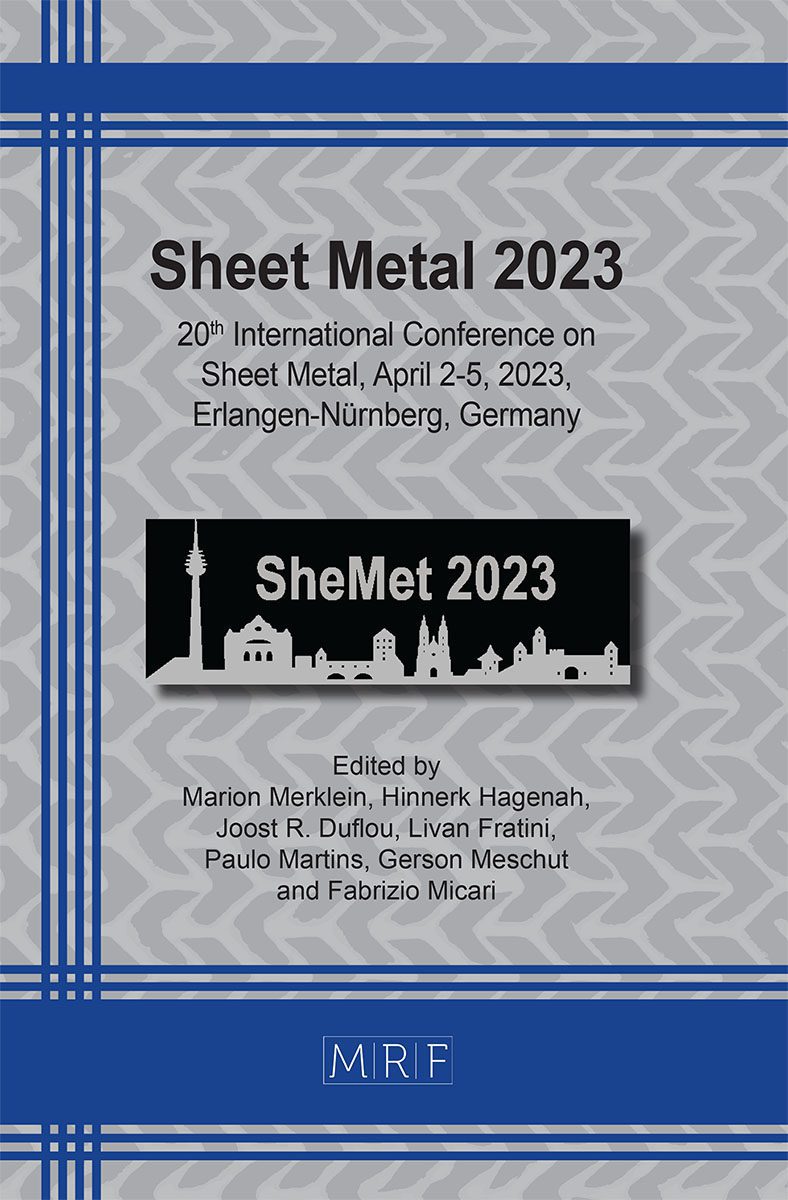Numerical analyses of the influence of a counter punch during deep drawing
Bernd-Arno Behrens, Daniel Rosenbusch, Hendrik Wester, Joshua Weichenhain, Philipp Althaus
download PDFAbstract. In the automotive sector, the demand for high crash safety and lightweight construction has led to an increased use of steels with higher strengths. However, the rising number of varying materials with different strengths and ductilities lead to an increasing complexity in production, making it more challenging to ensure robust processes. Therefore, the focus of current researches still lays on the further development and extension of forming processes to enable high productivity and reliable production. A powerful tool for an efficient optimisation and extension of forming processes is the Finite Element Method (FEM), which offers time- and cost saving potentials in the design phase. In deep drawing, the use of a counter punch offers the possibility of extending the process limits. By superimposing compressive stresses on the workpiece, the initiation of cracks can be delayed, thus higher drawing ratios can be achieved. The aim of this research is therefore the numerical investigation of a deep drawing process with a counter punch to analyse the influence on the crack initiation and identify optimisation potentials for the process. For this cause, the applied force as well as the position and geometry of the counter punch are varied and the influence on fracture initiation is evaluated. It is found that the applied force on the counter punch is the major influencing factor for crack initiation. Furthermore, it was concluded that the contact between the counter punch and the workpiece should be applied as soon as the bottom of the cup is shaped. A further improvement can be achieved if the counter punch is geometrically adapted to the bottom of the workpiece.
Keywords
Fracture Analysis, High Strength Steel, Process Extension
Published online 3/17/2023, 8 pages
Copyright © 2023 by the author(s)
Published under license by Materials Research Forum LLC., Millersville PA, USA
Citation: Bernd-Arno Behrens, Daniel Rosenbusch, Hendrik Wester, Joshua Weichenhain, Philipp Althaus, Numerical analyses of the influence of a counter punch during deep drawing, Materials Research Proceedings, Vol. 25, pp 329-336, 2023
DOI: https://doi.org/10.21741/9781644902417-41
The article was published as article 41 of the book Sheet Metal 2023
![]() Content from this work may be used under the terms of the Creative Commons Attribution 3.0 licence. Any further distribution of this work must maintain attribution to the author(s) and the title of the work, journal citation and DOI.
Content from this work may be used under the terms of the Creative Commons Attribution 3.0 licence. Any further distribution of this work must maintain attribution to the author(s) and the title of the work, journal citation and DOI.
References
[1] C. P. Singh, G. Agnihotri, Study of deep drawing process parameters: a review, Int. J. Sci. Res. Publ. 5 (2) (2015) 352-366.
[2] A. Meyer, B. Wietbrock, G. Hirt, Increasing of the drawing depth using tailored rolled blanks – Numerical and experimental analysis, Int. J. Mach. Tools Manuf. 48 (2007) 522-531. https://doi.org/10.1016/j.ijmachtools.2007.08.003
[3] P.D. Wu, J.D. Embury, D.J. Lloyd, Y. Huang, K.W. Neale, Effects of superimposed hydrostatic pressure on sheet metal formability, Int. J. Plast. 25 (9) (2009) 1711-1725. https://doi.org/10.1016/j.ijplas.2008.10.002
[4] A. Anil Kumar, S. Satapathy, D. Ravi Kumar, Effect of Sheet Thickness and Punch Roughness on Formability of Sheets in Hydromechanical Deep Drawing, J. Mater. Eng. Perform. 19 (2010) 1150–1160. https://doi.org/10.1007/s11665-010-9602-8
[5] W. Petzold, M. Otto, Increasing the LDR through additional radial compressive stress, J. Mater. Process. Technol. 170 (1–2) (2005) 151-155. https://doi.org/10.1016/j.jmatprotec.2005.04.114
[6] Y. Morishita, T. Kado, S. Abe, Y. Sakamoto, F. Yoshida, Role of counterpunch for square-cup drawing of tailored blank composed of thick/thin sheets, Jo J. Mater. Process. Technol. 212 (10) (2012), 2102-2108. https://doi.org/10.1016/j.jmatprotec.2012.05.011
[7] B.-A. Behrens, A. Bouguecha, C. Bonk, N. Grbic, M. Vucetic, Validation of the FEA of a deep drawing process with additional force transmission, AIP Conf Proc 1896 (2017) 080024. https://doi.org/10.1063/1.5008104
[8] P. Althaus, J. Weichenhain, S. Hübner, H. Wester, D. Rosenbusch, B. A. Behrens, Numerical and experimental failure analysis of deep drawing with additional force transmission, in: M. Liewald (Eds.), Production at the Leading Edge of Technology, Springer Nature, Switzerland, 2023, pp. 1-10.
[9] B.-A. Behrens, C. Bonk, N. Grbic, M. Vucetic, Numerical analysis of a deep drawing process with additional force transmission for an extension of the process limits, IOP Conf. Ser.: Mater. Sci. Eng. 179 (1) (2017) 012006. https://doi.org/10.1088/1757-899X/179/1/012006
[10] R. Hill, A theory of the yielding and plastic flow of anisotropic metals, Proc. R. Soc. Lond. 193 (1033) (1984) 281-297. https://doi.org/10.1098/rspa.1948.0045
[11] Y. Bai, T. Wierzbicki, Application of the extended Coulomb-Mohr model to ductile fracture, Int. J. Fract. 161 (1) (2010) 1-20. https://doi.org/10.1007/s10704-009-9422-8
[12] B.-A. Behrens, D. Rosenbusch, H. Wester, P. Althaus, Comparison of three different ductile damage models for deep drawing simulation of high-strength steels, IOP Conf. Ser.: Mater. Sci. Eng. 1238 (2022) 012021. https://doi.org/10.1088/1757-899X/1238/1/012021































